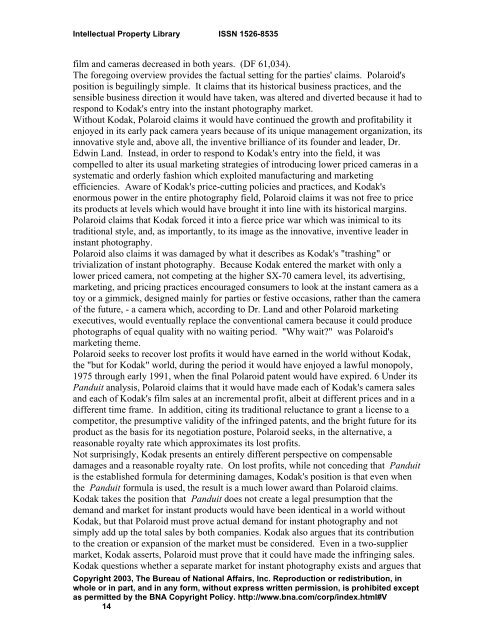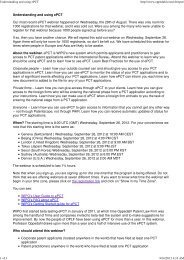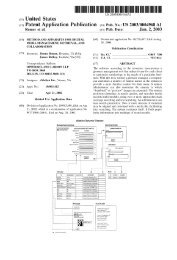Polaroid Corp. v. Eastman Kodak Co. - Oppedahl Patent Law Firm LLC
Polaroid Corp. v. Eastman Kodak Co. - Oppedahl Patent Law Firm LLC
Polaroid Corp. v. Eastman Kodak Co. - Oppedahl Patent Law Firm LLC
Create successful ePaper yourself
Turn your PDF publications into a flip-book with our unique Google optimized e-Paper software.
Intellectual Property Library ISSN 1526-8535<br />
film and cameras decreased in both years. (DF 61,034).<br />
The foregoing overview provides the factual setting for the parties' claims. <strong>Polaroid</strong>'s<br />
position is beguilingly simple. It claims that its historical business practices, and the<br />
sensible business direction it would have taken, was altered and diverted because it had to<br />
respond to <strong>Kodak</strong>'s entry into the instant photography market.<br />
Without <strong>Kodak</strong>, <strong>Polaroid</strong> claims it would have continued the growth and profitability it<br />
enjoyed in its early pack camera years because of its unique management organization, its<br />
innovative style and, above all, the inventive brilliance of its founder and leader, Dr.<br />
Edwin Land. Instead, in order to respond to <strong>Kodak</strong>'s entry into the field, it was<br />
compelled to alter its usual marketing strategies of introducing lower priced cameras in a<br />
systematic and orderly fashion which exploited manufacturing and marketing<br />
efficiencies. Aware of <strong>Kodak</strong>'s price-cutting policies and practices, and <strong>Kodak</strong>'s<br />
enormous power in the entire photography field, <strong>Polaroid</strong> claims it was not free to price<br />
its products at levels which would have brought it into line with its historical margins.<br />
<strong>Polaroid</strong> claims that <strong>Kodak</strong> forced it into a fierce price war which was inimical to its<br />
traditional style, and, as importantly, to its image as the innovative, inventive leader in<br />
instant photography.<br />
<strong>Polaroid</strong> also claims it was damaged by what it describes as <strong>Kodak</strong>'s "trashing" or<br />
trivialization of instant photography. Because <strong>Kodak</strong> entered the market with only a<br />
lower priced camera, not competing at the higher SX-70 camera level, its advertising,<br />
marketing, and pricing practices encouraged consumers to look at the instant camera as a<br />
toy or a gimmick, designed mainly for parties or festive occasions, rather than the camera<br />
of the future, - a camera which, according to Dr. Land and other <strong>Polaroid</strong> marketing<br />
executives, would eventually replace the conventional camera because it could produce<br />
photographs of equal quality with no waiting period. "Why wait?" was <strong>Polaroid</strong>'s<br />
marketing theme.<br />
<strong>Polaroid</strong> seeks to recover lost profits it would have earned in the world without <strong>Kodak</strong>,<br />
the "but for <strong>Kodak</strong>" world, during the period it would have enjoyed a lawful monopoly,<br />
1975 through early 1991, when the final <strong>Polaroid</strong> patent would have expired. 6 Under its<br />
Panduit analysis, <strong>Polaroid</strong> claims that it would have made each of <strong>Kodak</strong>'s camera sales<br />
and each of <strong>Kodak</strong>'s film sales at an incremental profit, albeit at different prices and in a<br />
different time frame. In addition, citing its traditional reluctance to grant a license to a<br />
competitor, the presumptive validity of the infringed patents, and the bright future for its<br />
product as the basis for its negotiation posture, <strong>Polaroid</strong> seeks, in the alternative, a<br />
reasonable royalty rate which approximates its lost profits.<br />
Not surprisingly, <strong>Kodak</strong> presents an entirely different perspective on compensable<br />
damages and a reasonable royalty rate. On lost profits, while not conceding that Panduit<br />
is the established formula for determining damages, <strong>Kodak</strong>'s position is that even when<br />
the Panduit formula is used, the result is a much lower award than <strong>Polaroid</strong> claims.<br />
<strong>Kodak</strong> takes the position that Panduit does not create a legal presumption that the<br />
demand and market for instant products would have been identical in a world without<br />
<strong>Kodak</strong>, but that <strong>Polaroid</strong> must prove actual demand for instant photography and not<br />
simply add up the total sales by both companies. <strong>Kodak</strong> also argues that its contribution<br />
to the creation or expansion of the market must be considered. Even in a two-supplier<br />
market, <strong>Kodak</strong> asserts, <strong>Polaroid</strong> must prove that it could have made the infringing sales.<br />
<strong>Kodak</strong> questions whether a separate market for instant photography exists and argues that<br />
<strong>Co</strong>pyright 2003, The Bureau of National Affairs, Inc. Reproduction or redistribution, in<br />
whole or in part, and in any form, without express written permission, is prohibited except<br />
as permitted by the BNA <strong>Co</strong>pyright Policy. http://www.bna.com/corp/index.html#V<br />
14





